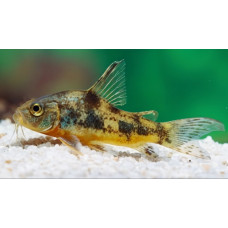Latin name
Corydoras paleatus
Other name
Mottled corydoras, and peppered catfish.
Identification
The Blue Leopard Corydoras has a strongly curved back line and an almost flat abdomen. Its body is covered in overlapping bony plates that form a protective shell. There are two pairs of antennae on the upper lip.
These fish are known to make sounds by withdrawing their pectoral fins. Males use this behaviour during courtship and intrapersonal communication, while both sexes and juveniles use it when they are in distress.
Features of fish fins
The dorsal fin of males is sharp and triangular, whereas the dorsal fin of females is rounded.
Fish colouring
The dorsal and pectoral fins are pale brown with many dark spots, and the abdomen is pinkish-gold. They come in albino and golden forms.
Distribution
These fish are native to the freshwater bodies of the La Plata Estuary Basin in southeastern South America.
Habitat
They are found in small lakes and puddles that are left behind when large rivers flood.
Size
The female grows to seven centimetres, while the male is usually one to two centimetres smaller.
Behavior
These gregarious and peaceful fish are quite active during the day and peak in activity at night. They live for six to eight years, sometimes up to fifteen.
During the breeding season, males do not behave aggressively towards each other or monopolise mating sites or females.
Food and feeding habits
Their diet consists of worms, crustaceans, insects and plants. They particularly enjoy eating the algae that grows on floating plants.
Reproduction
Sexual maturity is reached at six to eight months of age. The female lays around 200 eggs. The eggs are large and transparent, measuring 1.5–3 mm in diameter. The incubation period is 4–12 days depending on the temperature.
The males begin the courtship ritual by chasing the females around the aquarium. When the female is ready to spawn, she turns to the male beside her and nudges him with her pelvic fin. The male then releases sperm. The female then straddles the male's pelvic fins and lays several eggs (usually four to 12) on them. They lay the eggs all over the aquarium. After laying several eggs close together, the female rests for a while. Meanwhile, the males regroup and start chasing each other, before resuming the chase of the female.
Aquarium conditions
These fish prefer an aquarium temperature between 16 and 24 °C (61 and 75 °F), although they can tolerate lower temperatures as they inhabit colder waters. They do not tolerate high temperatures well; 30 °C (86 °F) is the highest safe temperature. Lighting should not be too bright, and they need shelters as they like to hide from light at certain times of the day.
| Classification | |
| Phylum | Chordata |
| Class | Actinopterygii |
| Squad | Siluriformes |
| Family | Callichthyidae |
| Genus | Corydoras |
| Species | C. paleatus |
| Features | |
| Conservation status | Least Concern |
| Habitat | Bottom |
| Life span, years | 15 |
| Maximum body weight, kg | No information |
| Maximum length, cm | 7 |
| Sailing speed, m/s | No information |
| Threat to people | Not edible |
| Way of eating | Planktonophage |
Blue leopard corydoras
Tags: blue leopard corydoras



